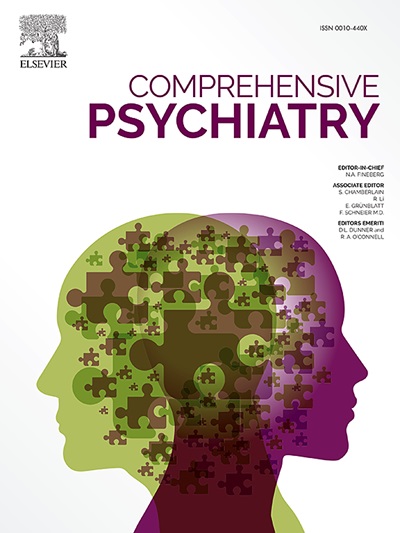The double-edged sword of distress tolerance: Exploring the role of distress overtolerance in nonsuicidal self-injury
IF 4.2
2区 医学
Q1 PSYCHIATRY
引用次数: 0
Abstract
Background
While low distress tolerance has been widely studied as a risk factor for nonsuicidal self-injury (NSSI), recent attention has shifted toward distress overtolerance—an individual's excessive endurance to distress despite severe adverse effects. Understanding this double-edged nature of distress tolerance is critical for developing effective intervention strategies to address the growing burden of NSSI. This study investigated the role of distress overtolerance in NSSI pathology.
Methods
The study comprised 1818 female participants, including 918 and 900 participants with and without a history of NSSI, respectively. Binary logistic regression models were utilized to analyze distress overtolerance as a predictor of NSSI engagement, versatility, and frequency while controlling for demographic variables, depression, anxiety, and emotion dysregulation. Among the participants with a history of NSSI, Pearson's correlation analyses were conducted to identify the functions of NSSI that were the most associated with distress overtolerance.
Results
Distress overtolerance was identified as a significant predictor of NSSI engagement, versatility, and frequency even after controlling for other risk factors. Distress overtolerance was most strongly linked to self-punishment function in individuals with a history of NSSI.
Conclusions
Distress overtolerance is a distinct and significant risk factor for NSSI, highlighting the need for its inclusion in mechanisms and intervention models for NSSI. Addressing distress overtolerance in therapeutic settings to achieve an optimal balance in distress regulation could provide innovative and more effective strategies for the treatment of NSSI.
痛苦容忍的双刃剑:探讨痛苦过度容忍在非自杀性自伤中的作用
背景:低痛苦承受能力作为非自杀性自伤(NSSI)的一个危险因素被广泛研究,最近的注意力转向了痛苦过度承受——个体对痛苦的过度承受,尽管有严重的不良影响。理解这种痛苦容忍的双刃剑性质对于制定有效的干预策略来解决自伤日益增加的负担至关重要。本研究探讨了应激过度耐受在自伤病理中的作用。方法本研究纳入1818名女性受试者,其中有自伤史的918名,无自伤史的900名。在控制人口统计变量、抑郁、焦虑和情绪失调的情况下,利用二元逻辑回归模型分析作为自伤参与、多功能性和频率预测因子的痛苦过度耐受。在有自伤史的参与者中,进行Pearson相关分析,以确定与痛苦过度耐受最相关的自伤功能。结果即使在控制了其他风险因素后,痛苦过度耐受也被确定为自伤参与、多功能性和频率的重要预测因子。在有自伤史的个体中,痛苦过度耐受与自我惩罚功能的关系最为密切。结论痛苦过度耐受是自伤的一个明显且重要的危险因素,需要将其纳入自伤机制和干预模式。在治疗环境中解决痛苦过度耐受,以实现痛苦调节的最佳平衡,可以为治疗自伤提供创新和更有效的策略。
本文章由计算机程序翻译,如有差异,请以英文原文为准。
求助全文
约1分钟内获得全文
求助全文
来源期刊

Comprehensive psychiatry
医学-精神病学
CiteScore
12.50
自引率
1.40%
发文量
64
审稿时长
29 days
期刊介绍:
"Comprehensive Psychiatry" is an open access, peer-reviewed journal dedicated to the field of psychiatry and mental health. Its primary mission is to share the latest advancements in knowledge to enhance patient care and deepen the understanding of mental illnesses. The journal is supported by a diverse team of international editors and peer reviewers, ensuring the publication of high-quality research with a strong focus on clinical relevance and the implications for psychopathology.
"Comprehensive Psychiatry" encourages authors to present their research in an accessible manner, facilitating engagement with clinicians, policymakers, and the broader public. By embracing an open access policy, the journal aims to maximize the global impact of its content, making it readily available to a wide audience and fostering scientific collaboration and public awareness beyond the traditional academic community. This approach is designed to promote a more inclusive and informed dialogue on mental health, contributing to the overall progress in the field.
 求助内容:
求助内容: 应助结果提醒方式:
应助结果提醒方式:


